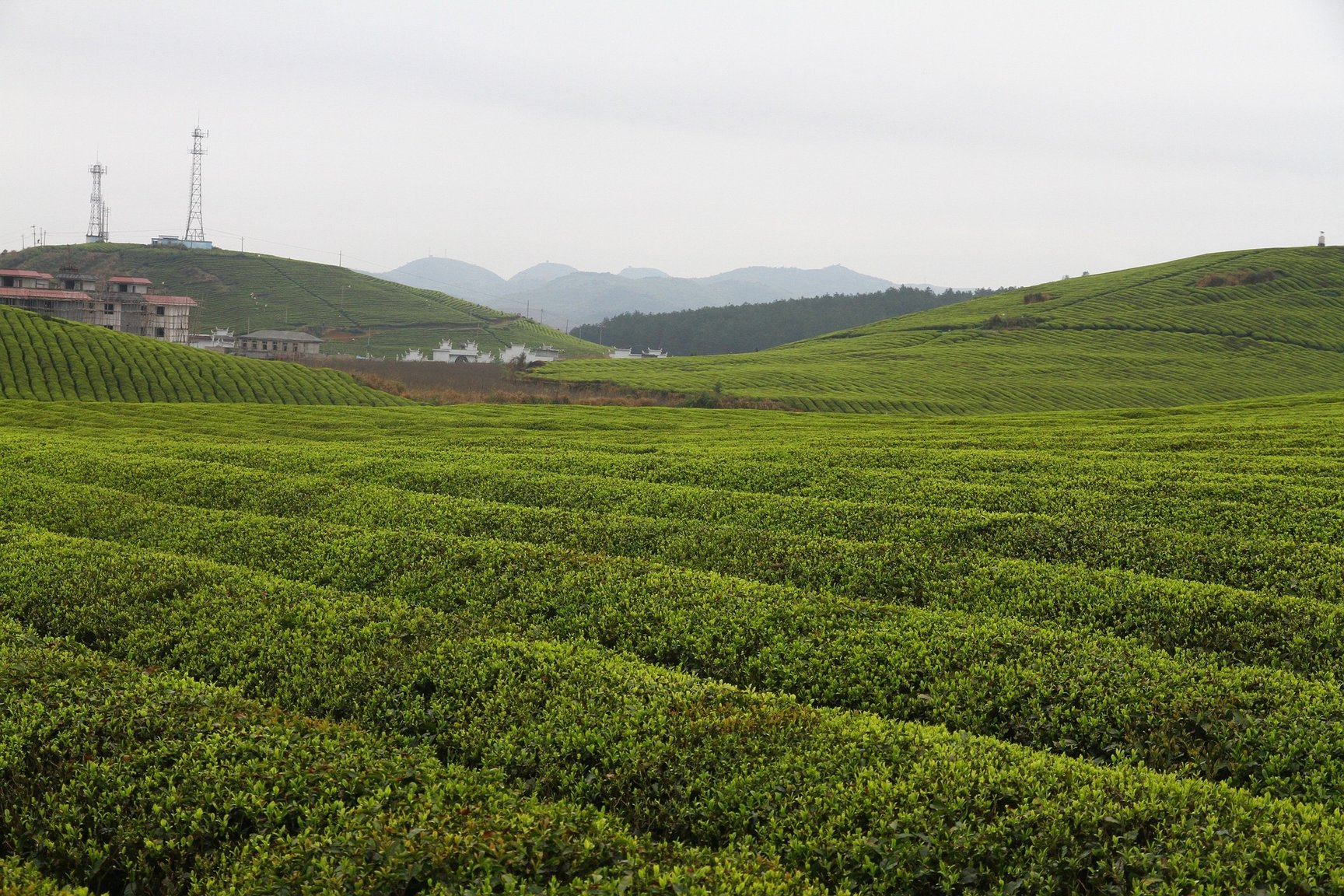
Regions of the World of Tea – Tea from China
In the second installment of the Academy of Tea, we’re looking at regions of the world and their role in the history, production and current tea industry. This week is tea from China. Below is a brief summary of China, it’s role in the history of tea, production of tea, it’s contributions to the world of tea and where it is currently in the tea industry today.

Geography of China
China is located in the eastern part of Asia. On its east border is the Pacific Ocean. It is the third largest country in area with an area of 9.6million squared kilometres. Its borders consist of 22 000km on land and 18 000km along the coastline.
Western China is plateaus and mountains while eastern China is Coastal low lands rising to mountains inland. Northern China is grassland and arid deserts. Southern china is dominated by hills and low mountains ranges. Eastern China is densely populated with central plains along the coasts of the Yellow Sea and the China Sea. Central eastern China is arable land and lies along deltas of the Huang He, Yellow River and Yangtze River, both centres of ancient Chinese civilization.
History of Tea in China
Shen Nong discovered tea in 2737BC when he was boiling water and some leaves blew into his pot of boiling water. The leaves brewed and a wonderful liquor and perfume was formed creating the first pot of tea. The tree from which the leaves blew was the first wild tea plant
In the Han (206BC – 220AD) and Six Dynasties (265-587AD) tea was first boiled with spices in south China.
In the 4th century tea started becoming part of daily life. It was used for medicinal purposes; the cultivation of started by the mid-4th century; this started in the Sichuan province; tea plants were planted on the hills where the drainage was good.
In 476AD international trade of Chinese tea began. The trading and bartering for tea along the Turkish border began.
In the 6th century tea became a social beverage due to the popularity among Buddhists. The role of Buddhism in the history of tea in Asia is very comparable to the role of Catholicism in the history of wine in Europe. Many of the early teas were named for mountains that were sites of Buddhist monasteries.
In the 8th century Lu Yu wrote the Ch’a Ching, the first book of tea.
Topics of the Ch’a Ching
- Origins of tea
- Tools for plucking and processing
- Methods of plucking and processing
- 25 utensils for preparing and serving
- Prepare tea by boiling
- Art of appreciating tea
- Famous tea drinkers and tea stories
- Tea producing districts
- Preparing and serving in a simplified manner
- Directions for creating illustrations of tea procedures.
In the Tan Dynasty, 618-907AD, tea was pounded and mixed with ginger, leek, mint and orange peel. Tea spread beyond south of China. It was ground into a powder and served with hot water in a bowl with salt. (The start of matcha?)
During the Song Dynasty (960-1279AD) the aesthetic quality, refinement and sophistication, of tea was more prevalent. Quality and beauty were highly valued resulting in more tea preparation tea ware, utensils, bowls and caddies, being made. Tea starting to be served whipped in a bowl more.
In the Yuan Dynasty, 1271-1368AD, cream was added to tea and it was becoming a part of meals. (Or were meals being added to tea?)
In the Ming Dynasty, 1368-1544AD) tea was being steeped in teapots; new brewing methods were being developed to prevent the bitterness of tea; smaller teapots were being made to prevent that over steeping and bitterness. This gave rise to Yixing, purple clay, teapots which became very popular.
During the Qing Dynasty, 1666-1911AD) the quality of teapots improved; new production methods for black and oolong teas were being developed. The production of oolong gave rise to new steeping methods in particular gong Fu style steeping; the use of a Gawain (cups with lids and saucers).
The Tea Horse Road was established 2000 years ago. This road was a trade route from Western China to Southern Tibet and from Western Sichuan to Central Asia, Mongolia and Siberia. Horses were obviously used on this route and were a valuable commodity as a result, during the Song Dynasty. In 1074, 20 000 war horses were traded for 7 million kilograms of tea. The compressed brick tea was valuable and used a currency in Tibet.
In the Tan Dynasty the Imperial Tea Tribute came into effect. This was the first form of taxation demanded from peasants by the Emperor. The impact was devastating. Tea production was a same time as rice fields needed to be planted. Farmers were forced to grow tea and neglect rice fields. This lead to famine and hunger later in the year. The demand for tea continued to grow. The Tea Tribute sold to traders to boost the economy however it has no benefit to the peasants doing the work because private trade was forbidden.
Tea Industry in China
The tea plantations in China are different from the British model. Today’s tea gardens are expansions of early tea gardens planted in the Tang and Ming Dynasties. They area loosely connected network of isolated gardens consisting of state owned and independent, privately owned collectives. The independent privately owned cooperative share local resources for labour, harvesting, processing, and distribution.
In the 1970s-1980s there was a restructuring of agricultural systems. Farming communes were disbanded. Farmers were now allowed to grow their own crops on their own land. The government still contracted to buy most of the harvest and also operates larger scale farms. A less productive method of harvesting is used during this time. While China has half of the world’s tea gardens, it only produces 20% of the world’s tea.
In 1990s, the average yield of tea from china was 500kg/hectare, compared to 2000kg/hectare from India.
Chinese Tea Ceremony
The Chinese tea ceremony is well known or at least the idea of a ceremony. This ceremony is called Gong Fu Cha, meaning “creating tea skillfully”. Ironically, the focus of the Chinese Tea Ceremony is on the appreciation of tea rather than on the procedures as it is in the Japanese Tea Ceremony.
Tools for Gong Fu Cha
- Yixing clay teapot
- Water dispensing tray
- Wooden teaspoon
- Tea pitcher
- Tea strainer
- Wooden tweezer
- Tasting cups and aroma cups
- Tea towel
Setup for Gong Fu Cha
- Warm the pot and heat the cups
- Appreciate excellent tea
- “Black dragon enters the palace”
- Rinse from elevated pot
- “The spring wind brushes the surface”
- “Bathe the immortal”
- “A row of clouds, running water”
- Pour again from a low height
- Bathe the sniffer cup
- “Walk in the mountains and play in the river”
- “The dragon and phoenix in auspicious union”
- “The carp turns over”
- Respectfully receive the fragrant tea
References:
- Tea 102, Academy of Tea, URL: https://academyoftea.org/tea102/
- Tribute tea (Gong Cha) and Chinese Tea History, Amazing Green Tea, URL: https://www.amazing-green-tea.com/tribute-tea.html
- The Ancient Tea Horst Road, China Highlights, URL: https://www.chinahighlights.com/travelguide/special-report/tea-horse-road/
- Gong Fu Cha – The Complete Guide to making Chinese tea, Lui, Daniel, The Chinese Tea Shop, URL: http://www.thechineseteashop.com/gong-fu-cha.html
- Gong Fu Ceremony, Teas Class, URL: https://www.teaclass.com/lesson_0318.html
- The Traditional Gongfu Tea Ceremony: A Complete Guide, Teasenz, URL: https://www.teasenz.com/chinese-tea/gongfu-tea-ceremony.html
- China Geography, worldatlas.com, URL: https://www.worldatlas.com/webimage/countrys/asia/china/cnland.htm
- Everyone will love this hazelnut spread stuffed cookies recipe - November 18, 2024
- The Greely Good Market is a Modern Outdoor Market - September 3, 2024
- Our Quick Visit to the Petawawa Container Market - September 3, 2024






